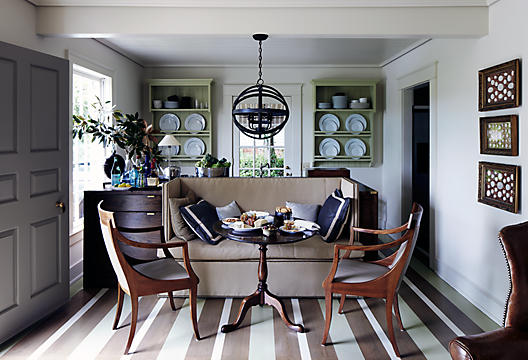Do I really need a dining table in my apartment or a sofa in my living room? Do I need to purchase these “standard” pieces of furniture?
Ever feel like the usual furniture pieces of furniture aren’t for you? The journey from childhood home to the chosen “grown-up” home varies greatly from person to person. And how you choose to decorate your home should be entirely personal, based on your needs, wants and style. When it comes to design blogs and magazines, there can often be an invisible peer pressure to decorate or design your home just like everyone else. Just remember that even though there are certain standards or guidelines in design (mostly for ergonomic and safety reasons) there are numerous ways to make any dwelling feel like home. The wonderful thing about interior design and decoration is that there are no rules. And even if you think there are rules to follow, chances are someone has broken all of them only to be celebrated as a true genius and visionary.

This unconventional dining room is hardly standard. It consists of a knole sofa instead of chairs, an end table instead of a dining table, and a pair of armchairs that you might see in a living room.
So to answer the above question: no, you don’t need a dining table in your dining room and you don’t need to relax on 3-seater sofa in your living room. But standard furniture pieces, like a dining table, does add convenience for most people and tends to fit within the typical room shape and size. The same can be true for many standard pieces like the sofa, bed, nightstand, or dining chairs. In the same vein, you don’t need a place setting for 12, you don’t need to make your bed with a top sheet, and you don’t need to have doors on your kitchen cabinets. Throughout history people have created standards in furniture design and room design (like kitchen design) mostly to address the needs for comfort and efficiency. And some standards have developed because of our natural attraction to symmetry and balance. But how a furniture designer interprets those comforts and efficiencies is where we see true talent and vision.
Take for example the LC4 Chaise Longue, designed in 1928 by Le Corbusier, his cousin, Pierre Jeanneret, and architect Charlotte Perriand. Le Corbusier (Charles-Edouard Jeanneret) was a modernist with a passion for Greek architecture, and desire to create traditional forms using modern machinery. He wrote that the house should be “a machine for living” and created architecture and furniture that epitomized this new International Style. The LC4 wasn’t quite a sofa; it wasn’t an armchair, or a bed, or a rocking chair either. Despite not being a “normal” piece of furniture, it offered full-body support, ergonomics and comfort in a very minimalist manner (Le Corbusier referred to it as a “relaxing machine”). Behind the modernist façade of the LC4 is a seat that was created with absolute comfort in mind. Charlotte Perriand wrote that the design was influenced by watching soldiers rest: “(the soldier) lies down on his back, puts his feet up against a tree, with his knapsack under his head.”

The LC4 Chaise Longue, designed in 1928 by Le Corbusier, his cousin, Pierre Jeanneret, and architect Charlotte Perriand.
The chair itself is anthropomorphic, mimicking the human form and making this piece fit the body extremely well. Additionally, the design of this chair allows the user to place it in a zero-gravity position, relieving pressure on the lower back. In the book Deconstruction Product Design , authors William Lidwell and Gerry Manacsa describe the LC4 thusly: “At full recline with the hips and knees bent, the back assumes the neutral position, maintaining the proper S-curve of the spine and relieving pressure on the back. Additional benefits of the position include improved circulation, reduced stress on the heart, and facilitated breathing. There is a reason astronauts assume this position on liftoff.” Most people today might find this chair to be a bit narrow, and some even ask, “Where do I rest my elbows?” But those thoughts tend to disappear once you actually lie down in it.

Definitely not your usual kitchen design. Antique cabinets, a countertop wrapped in brass and an antique daybed create a dramatically different (and gorgeous) kitchen.
The furniture you choose to decorate with should help your home function and create efficient spaces. But keep in mind that you might use your rooms differently than others. If eating your meals while sitting on the ground around a low coffee table is preferred, go for it! If you prefer the look of armchairs or daybed platforms to a traditional sofa, or using vintage furniture that had a makeover, try it out. Don’t feel pressured into buying what everyone else is buying for his or her homes. Just like fashion, unconventional interior design can still be functional, beautiful and enjoyable.
Tell us, what unusual furniture choices have you made for your home?
Top image credit: Non-traditional bathroom by Dimore Studio




